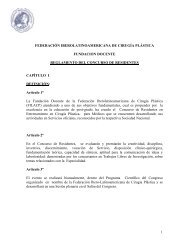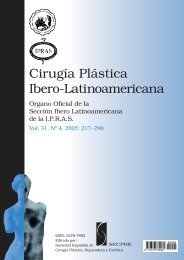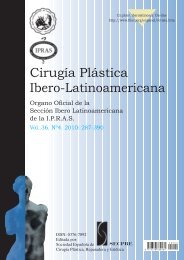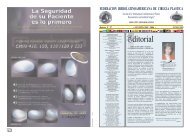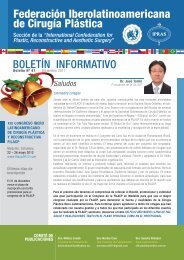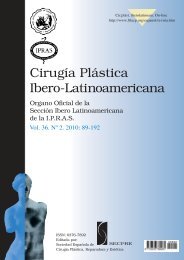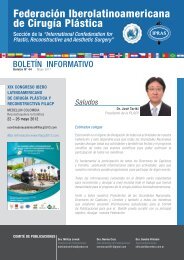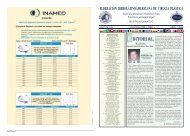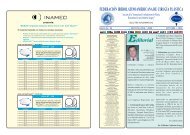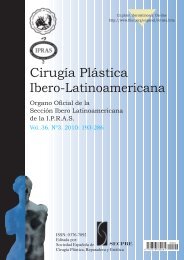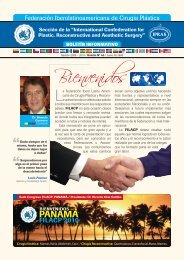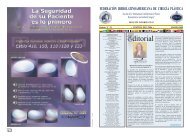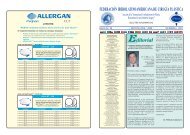Volumen 37 No. 4 - Planetec
Volumen 37 No. 4 - Planetec
Volumen 37 No. 4 - Planetec
Create successful ePaper yourself
Turn your PDF publications into a flip-book with our unique Google optimized e-Paper software.
CIRUGÍA PLÁSTICA IBERO-LATINOAMERICANA<br />
Cir.plást. iberolatinoam.-Vol. <strong>37</strong> - Nº 4<br />
Octubre -<strong>No</strong>viembre-Diciembre 2011 / Pag. 311- 318<br />
Injertos de tejido adiposo: variables que influyen<br />
en la viabilidad del adipocito y de las células<br />
madre mesenquimales<br />
Fat grafting: variables that influence the viability of the adipocyte<br />
Benito Ruiz, J.*<br />
and mesenchimal stem cells<br />
Benito Ruiz, J.<br />
Resumen<br />
Abstract<br />
Si bien los injertos de tejido adiposo se han venido utilizando<br />
durante décadas a lo largo del siglo pasado, la técnica<br />
se venía considerando como poco útil dado que el<br />
injerto tendía a la reabsorción. Fue Coleman quien introdujo<br />
un sistema de obtención-procesamiento-infiltración<br />
atraumático que aumentó el porcentaje de supervivencia<br />
del injerto y la obtención de resultados positivos similares<br />
en su aplicación en todo el mundo.<br />
Aún así, la publicación de resultados dispares en la literatura<br />
respecto a la supervivencia del injerto, con diferentes<br />
porcentajes de reabsorción y el descubrimiento de<br />
las células madre en el tejido adiposo, han llevado a la<br />
realización de numerosos trabajos de investigación encaminados<br />
a comprender la biología del injerto de tejido adiposo,<br />
a estudiar el papel de las células madre en este<br />
proceso y la influencia que sobre la viabilidad celular tienen<br />
los distintos pasos a los que los cirujanos plásticos sometemos<br />
al tejido adiposo para su trasplante.<br />
Hemos hecho una revisión de la literatura científica al<br />
respecto para reunir la información disponible sobre estas<br />
controversias.<br />
Though adipose tissue grafts have been used for decades<br />
in last century, the technique has been considered<br />
as slightly usefull provided that the graft was tending to<br />
reabsorption. It was Coleman who introduced a system<br />
of atraumatic harvesting-processing-infiltration that increased<br />
the percentage of survival of the graft obtaining<br />
positive similar results in its application all over the<br />
world.<br />
<strong>No</strong>netheless, publication of unlike results in the literature<br />
regarding survival of the graft with different percentages<br />
of reabsorption and the discovery of stem cells<br />
in the adipose tissue, have led to the accomplishment of<br />
numerous research works directed to understanding the<br />
biology of the fat graft, the role of the stem cells in this<br />
process and the influence that the different steps for<br />
transplantation have on the cellular viability.<br />
We present a review of the scientific literature about<br />
the theme to bring together the available information<br />
about these controversies.<br />
Palabras clave Grasa, Tejido adiposo, Injertos grasos,<br />
Lipoestructura, Células madre,<br />
Adipocitos, Preadipocitos, Coleman<br />
Código numérico 19-266<br />
Key words Fat, Adipose tissue, Fat grafting,<br />
Lipostructure, Stem cells,<br />
Adipocytes, Preadipocytes, Coleman<br />
Numeral Code 19-266<br />
* Especialista en Cirugía Plástica, Estética y Reparadora. Clínica Tres Torres, Barcelona, España.



